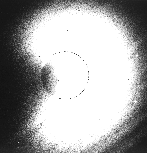|
The hydrogen atom, having lost an electron, becomes an ion (proton), and
because of its low energy, contributes very little to the ring current. On the
other hand, the ring current ion which has gained an electron is now
neutralized, becoming a fast neutral atom with a great deal of energy. Since
the Earth's magnetic field can only trap charged particles, the fast atom
usually disappears quickly into distant space. In this way the "charge
exchange" process gradually removes newly added particles from the ring current.
Only the more energetic ones remain, since their probability of undergoing
charge exchange is much lower.
This process may have an unusual application, by letting us observe the ring
current from a distance, the way astronomers observe distant stars through their
telescopes. Astronomers use light, which moves in straight lines. Similarly,
if one could build a camera that uses energetic neutral atoms (ENA) created in the ring current by charge exchange, it might be able to picture the ring current, too, since ENAs also move along straight lines.
An "Image " mission using such a camera has in fact been approved by NASA. Technically this is a rather difficult feat
because the number of ENAs coming from the ring current, especially outside
magnetic storms, is rather small. A pilot experiment of this type ran for five
weeks aboard the Swedish satellite Astrid, launched in December 1994, and
produced some very simple ENA images.
Storms and Substorms
What creates a magnetic storm?
Substorms have now been studied for many years, from space and from the
ground. Their details vary from one event to the next, just as thunderstorms in the atmosphere never seem alike, but many scientists have nevertheless concluded that they are a fundamental mode of energy release and particle acceleration.
In contrast, it is not at all clear that magnetic storms are similarly
fundamental. Their main distinguishing feature is the injection of many
energetic ions and electrons from the tail, causing the ring current to grow
significantly. Yet substorms also inject such particles, as was shown in 1971 by the instruments aboard the synchronous ATS-1, an experimental communication satellite with a "piggyback" scientific payload. Many other satellites have studied substorm injections since then: it is just that the injected particles are fewer, their penetration less pronounced and their average energy lower.
Is then a magnetic storm merely a series of large and intense substorms? That was apparently the view of Sydney Chapman (1888-1970), distinguished researcher of magnetic storms, who introduced the term "substorm" to suggest precisely this idea. Chapman noted in 1963 that the same storms which at near-equator observatories, e.g. in Hawaii, followed simple curves of growth and decay, in Alaska seemed to consist of a number of distinct "sub-storms."
Although substorms also exist at other times (as S. Akasofu, Chapman's
student, discovered soon afterwards), there might be a difference. "Garden
variety" substorms do not need much of a stimulus: during times of southward interplanetary field, the tail seems to quickly reach the brink of instability, and small changes in the solar wind can then precipitate a substorm. Magnetic storms on the other hand seem to come from much more powerful sources, in general from the arrival of interplanetary shocks (though southward IMF is also a strong
factor).
M-regions and Coronal Holes
The connection between magnetic storms and sunspots was well established
around the turn of the century. When large active sunspots were visible, big
magnetic storms were much more likely. In today's terminology one might say
that the intense field of sunspots was likely to lead to sudden releases of
magnetic energy, manifested by flares and coronal mass ejections, and those in their turn sent out fast interplanetary plasma clouds whose shock fronts caused magnetic storms.
The relation between sunspots and smaller magnetic storms, however, seemed
less firm. In 1904 E.W. Maunder of the Royal Observatory in Greenwich, England, proposed that many such storms belonged to an entirely different class, tending to recur at intervals of 27 days, the Sun's rotation period. It was as if something on the rotating Sun was beaming those storms at us. However,
attempts to identify those regions on the Sun suggested that they were bland and featureless, containing no sunspots. Astronomers named them "M
regions" (M for magnetic storms), and for a long time no one had a clue about what set them apart.
|



 Official GSFC Home Page
Official GSFC Home Page  NASA WWW Home Page
NASA WWW Home Page